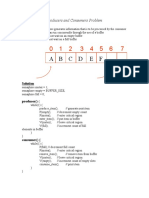0% found this document useful (0 votes)
101 views3 pagesClassical IPC Problems
The document outlines classical inter-process communication (IPC) problems, including the Dining Philosophers, Bounded Buffer, Sleeping Barber, and Readers-Writers problems, highlighting their definitions, main challenges, and typical solutions. Each problem involves specific processes and shared resources, with advantages and disadvantages discussed, such as deadlock and starvation risks. Additionally, the document provides code snippets demonstrating semaphore usage for each problem, illustrating practical implementations.
Uploaded by
jaineshchaurasiya20Copyright
© © All Rights Reserved
We take content rights seriously. If you suspect this is your content, claim it here.
Available Formats
Download as PDF, TXT or read online on Scribd
0% found this document useful (0 votes)
101 views3 pagesClassical IPC Problems
The document outlines classical inter-process communication (IPC) problems, including the Dining Philosophers, Bounded Buffer, Sleeping Barber, and Readers-Writers problems, highlighting their definitions, main challenges, and typical solutions. Each problem involves specific processes and shared resources, with advantages and disadvantages discussed, such as deadlock and starvation risks. Additionally, the document provides code snippets demonstrating semaphore usage for each problem, illustrating practical implementations.
Uploaded by
jaineshchaurasiya20Copyright
© © All Rights Reserved
We take content rights seriously. If you suspect this is your content, claim it here.
Available Formats
Download as PDF, TXT or read online on Scribd
/ 3
























































































